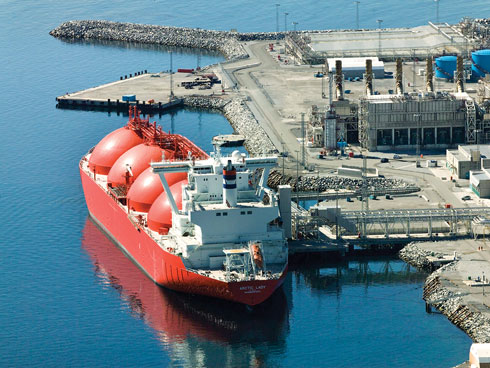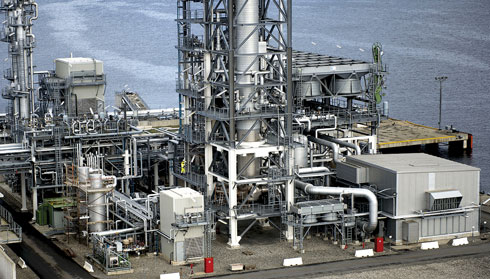Industry Trends: Norway targets global LNG market
E. Gerden, Contributing Writer
Norway aims to become a leading player in the global LNG market during the next several years through the establishment of new, large-scale LNG terminals. At present, Norway is the third-largest exporter of gas in the world, providing approximately 25% of the EU’s gas demand. The country is Russia’s main competitor in the European gas market. In 2017, Norway raised its gas exports to 122 Bm3.
Domestic consumption of gas in Norway is low, and nearly all the country’s gas production is exported. Most Norwegian gas sold on the European market is delivered to Germany, the UK, Belgium and France. Norwegian gas accounts for 20%–40% of total gas consumption in these countries.
Realizing Norway’s LNG potential. Just one-third of Norway’s estimated gas resources has been produced. While the country has a developed pipeline gas network, the full potential of its LNG segment has not yet been realized. At present, LNG accounts for less than 5% of Norway’s gas exports.
According to plans of the government and leading local producers, these figures should significantly increase over the coming years. At present, total production of LNG in Norway is estimated at 4.5 metric MMtpy. According to analyst predictions, this could double during the next several years.
 |
|
FIG. 1. An LNG ship at Statoil’s Hammerfest LNG plant in northern Norway. |
Greater exports of LNG will be achieved through production increases at some of the country’s largest gas fields. According to reports by Norwegian media, one such project is being implemented by domestic oil giant Statoil, which recently announced a plan to invest up to NOK 5 B ($600 MM) in the development of the Askeladd gas field. The Askeladd field lies in the Barents Sea, approximately 140 km northwest of Hammerfest in northern Norway. The field will become a new source of gas feedstock for the LNG plant in Hammerfest (Fig. 1). The export capacity of Hammerfest LNG is estimated at 4.3 metric MMtpy–5.75 metric MMtpy, which is equivalent to approximately 40 LNG tankers/yr.
The development of the field will be part of the large Snøhvit LNG project, which involves the development of three gas fields in the Norwegian zone of the Barents Sea: Snøhvit, Albatross and Askeladd, all 250 m–345 m deep. These fields, which were first discovered in the 1980s, have estimated reserves of 193 Bm3 of natural gas, 17.9 Bm3 of condensate and 5.1 metric MMt of NGL. The Snøhvit and Albatross fields came onstream in 2007.
 |
|
FIG. 2. The Sn.hvit LNG export terminal at Hammerfest LNG on Melk.ya Island, offshore Norway. |
The gas production systems at these fields use a subsea production platform that supplies gas via 143 km of pipeline to an LNG processing plant on Melkøya Island near Hammerfest (Fig. 2). The project also has a carbon dioxide (CO2) capture-and-storage facility located 2.6 km beneath the seabed of the Snøhvit field, with a 153-km pipeline for reinjection. The facility can store 700,000 metric tpy of CO2.
At the initial stage of the project, the partners (including Statoil, Dea Group, Petoro, Total E&P Norge, GDF Suez E&P and Hess) plan to drill three wells at Askeladd and connect the gas field to the already existing infrastructure. The commercial launch of the Askeladd field will ensure stable LNG production at Hammerfest LNG until at least 2023; existing reserves will pad gas supply for Snøhvit through 2050. Total investment in the project’s development is estimated at NOK 51.3 B ($5.3 B), part of which will be provided by the Japan Bank for International Cooperation.
LNG production from Askeladd is slated mainly for Europe; however, Statoil and its partners have not ruled out the possibility of sending increased supplies to the Asia-Pacific region, especially since Russia plans to begin massive exports of LNG to promising Asian markets.
In the meantime, Statoil’s plan to increase production of LNG at Norway’s flagship offshore gas field has already been welcomed by the country’s government, which has repeatedly criticized the slow rates of development of Norway’s largest gas fields.
According to estimates from the Norwegian Petroleum Directorate, two-thirds of the already discovered natural gas reserves on the Norwegian shelf have not been developed, and no plan has been put in place to exploit them. A spokesperson for the Directorate said the capacities of these offshore fields would be adequate to maintain production above 120 Bm3/yr until 2024. However, unless new discoveries are made, domestic gas production will gradually decline from the mid-2020s.
In the meantime, the Norwegian government expects production at other LNG plants within the country to increase from 2019–2020. The largest LNG plants in Norway include Risavika (300,000 metric tpy), Snurrevarden (20,000 metric tpy), Kollsnes 1 (40,000 metric tpy) and Kollsnes 2 (80,000 metric tpy).
Small-scale LNG and bunkering. Norwegian companies involved in the transport of small-tonnage LNG are keen to diversify their LNG sources to ensure reliable gas supply to consumers.
 |
|
FIG. 3. The LNG plant at Risavik, Tjoraberga, Norway. |
In December 2017, Skangas, the owner of the Risavik LNG terminal (Fig. 3), signed a letter of intent with National Grid Grain LNG in the UK. Under the terms of the agreement, Skangas will source LNG at the Grain LNG import terminal on the UK’s Isle of Grain. The deal will help ensure that a reliable supply of LNG is available, which is critical to the fast-growing small-scale LNG market.
Global interest in small-scale LNG is increasing. In line with this trend, most analysts believe that demand for the use of small-capacity gas carriers will continue to grow on the European continent, which will lead to a reduction in shipping costs.
Norway is already a world leader in the use of LNG for bunkering. As of 2017, approximately half of the more than 100 vessels in the world that use LNG as a fuel have come from Norway. The country’s LNG-operated fleet includes ferries, patrol vessels, tugboats, tankers and platforms for supplying vessels.
Environmental push. In addition to the further development of LNG export infrastructure, the Norwegian government will continue to promote the use of LNG within the country as part of a national commitment to reduce NOx emissions.
In accordance with the Protocol to Combat Acidification, Eutrophication and Ground Ozone, ratified in Gothenburg in 1999, Norway aims to reduce NOx emissions by 30% against the 1990 baseline level. For this purpose, a NOx emissions tax (approximately $2.60/kilo of emissions) has been applied since 1997 at power plants, engines, boilers, turbines, and flares on land and at sea. GP
EUGENE GERDEN is an international contributing writer specializing in the global oil refining and gas industry. He has been published in a number of prominent industry publications.




Comments